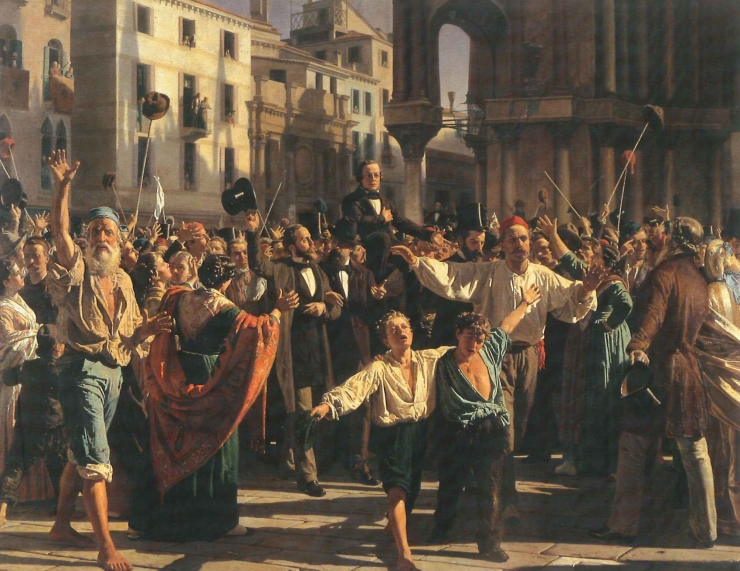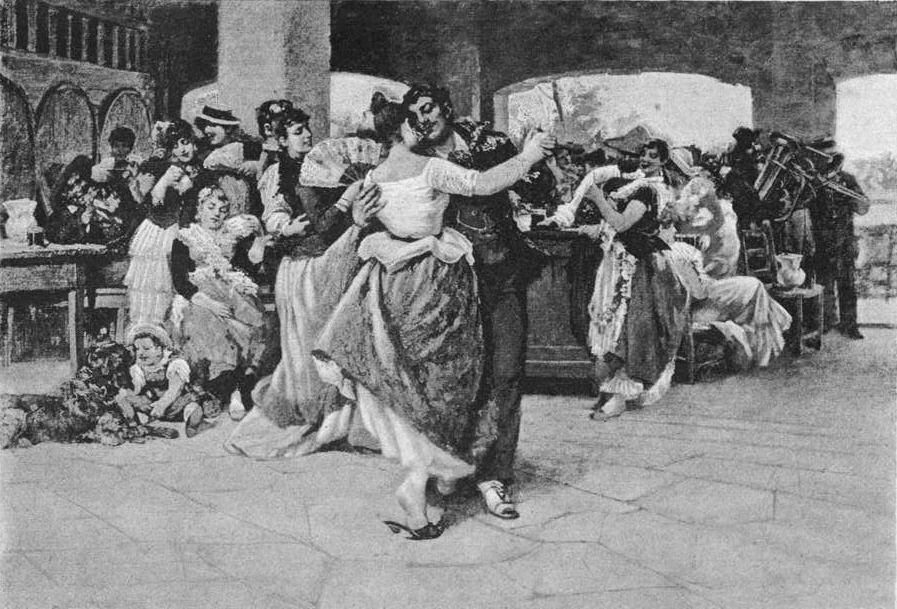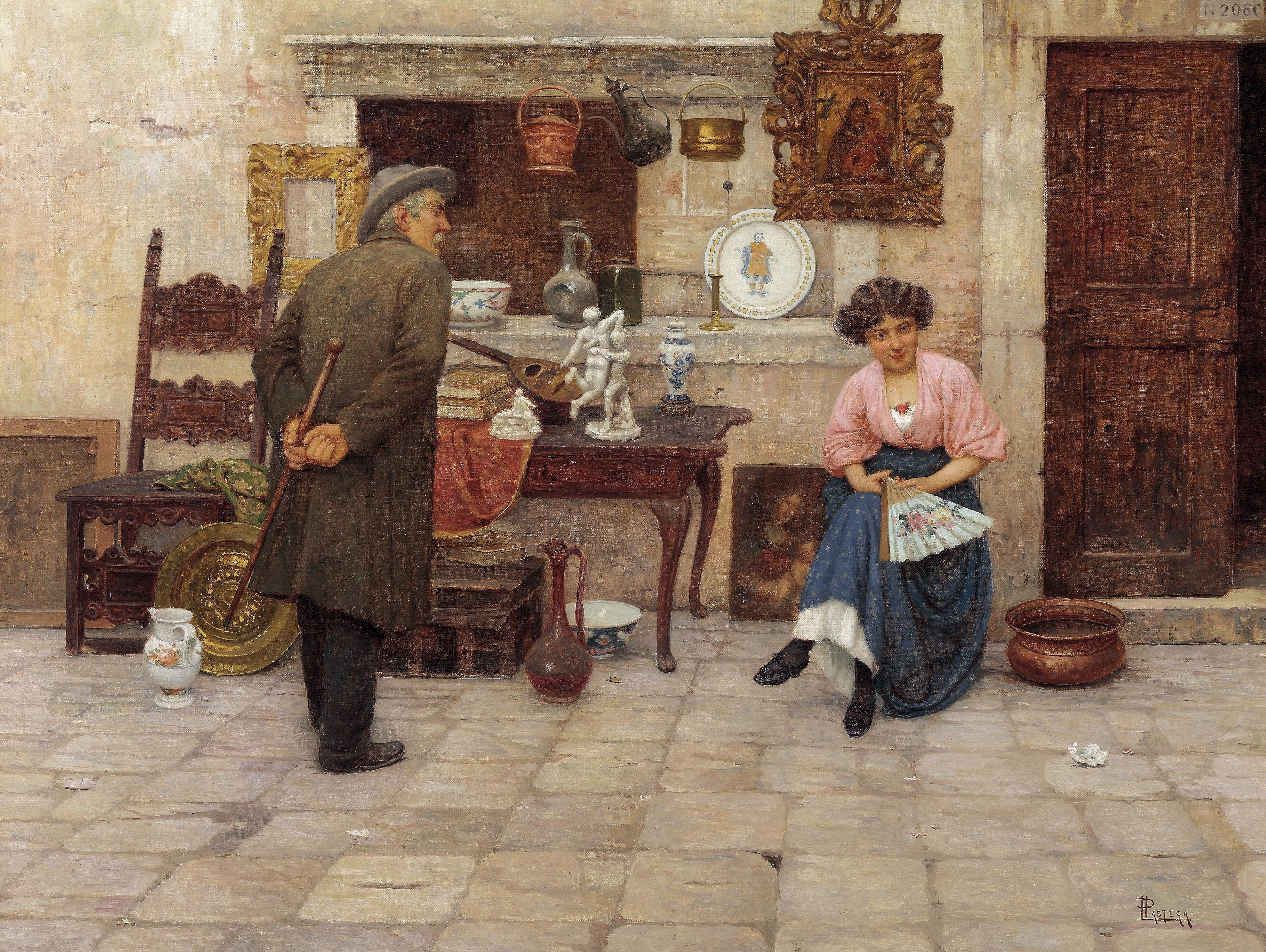|
Pompeo Molmenti
Pompeo Marino Molmenti (8 November 1819, Villanova in Motta di Livenza – 17 December 1894, Venice) was an Italian painter. Biography He was born in Friuli to Francesco Molmenti, an engineer of comfortable means, who had followed his older brother, Ettore, to Venice. When he was orphaned as a boy, Pompeo was cared for by his uncle Ettore, who encouraged his studies. In 1834, he was enrolled in the Accademia di Belle Arti di Venezia to study under Ludovico Lipparini, Odorico Politi, and Michelangelo Grigoletti. As a student he painted a ''Murder of Caesar''. One of his early patrons was Count Spiridione Papadopoli (1799-1859) and his wife, Teresa Mosconi, who owned a villa in Villanova, not far from Molmenti's birthplace. As a young man, he had painted a ''Death of Othello'' for the family. A second version was completed in 1866. During 1835 to 1840, Molmenti painted a ''Madonna and child'' for a lunette at the private oratory of the Papadopolis, which recalled the Renaissance ... [...More Info...] [...Related Items...] OR: [Wikipedia] [Google] [Baidu] |
Pompeo Molmenti - Pia De' Tolomei Condotta In Maremma
Pompeo is both a masculine Italian given name and a surname, derived from the Roman "Pompeius". Notable people with the name include: Given name: *Pompeo Aldrovandi (1668–1752), Italian Cardinal of the Roman Catholic Church *Pompeo Aldrovandini (1677–1735), Italian painter of the Baroque period *Pompeo Batoni (1708–1787), Italian painter *Pompeo Cannicciari (1670–1744), Italian composer *Pompeo Colonna (1479–1532), Italian Cardinal, politician and condottiero *Pompeo Coppini (1870–1957), Italian sculptor who emigrated to the United States * Pompeo D'Ambrosio (1917–1998), Italian who became a Venezuelan businessman *Pompeo Ghitti (1631–1703), Italian painter of the Baroque period *Pompeo Landulfo (1515–1590), Italian painter of the Renaissance period *Pompeo Marchesi (born 1790), Lombard sculptor of the neoclassical school *Pompeo Posar (1921–2004), Playboy magazine staff photographer *Pompeo Targone, Italian military engineer in the service of Ambrose Spinol ... [...More Info...] [...Related Items...] OR: [Wikipedia] [Google] [Baidu] |
Conegliano
Conegliano (; Venetian: ''Conejan'') is a town and ''comune'' of the Veneto region, Italy, in the province of Treviso, about north by rail from the town of Treviso. The population of the city is of people. The remains of a 10th-century castle are situated on a hill that dominates the town. Formerly belonging to the Bishop of Vittorio Veneto, what remains is a bell tower, which now houses a small museum, and outer walls. On 7 July 2019, Le Colline del Prosecco di Conegliano e Valdobbiadene was inscribed as a UNESCO World Heritage Site. Industry Conegliano is noted for its wine, chiefly the dry white Prosecco (made from the glera grape) which comes in three varieties: tranquillo (still), frizzante (slightly sparkling) and spumante ( sparkling). It is also home to Italy's oldest and most prestigious wine school called Scuola Enologica. It is also home to the Istituto Sperimentale per la Viticoltura where several Italian grape varieties have been bred, including Albarossa, Vega ... [...More Info...] [...Related Items...] OR: [Wikipedia] [Google] [Baidu] |
Napoleone Nani
Napoleone Nani (1841–1899) was an Italian painter, active in Venice, where he became professor of the Accademia di Belle Arti. Biography He was born in Venice. In 1877 at Naples, he displayed his self-portrait and a canvas titled ''La posa''. In 1881 in Venice, he displayed ''La macchina riposa'' and ''il cuore lavora''. At the 1883 Promotrice of Florence: ''Lo studio dal vero''; at Rome the same year: ''Lo studio del nudo'' and ''Il primo pensiero ai miei fiori''. Successively in Turin, Milan, and Rome, he exhibited: ''Vizio'', ''Trattative di conciliazione'', ''Giudizio di un intelligente'', and ''Studio''. To Venice, in 1887, ''Studio dal vero'' and ''La modella''; at the 1889 Florentine Promotrice: ''In assenza della Maestri''. Among his pupils were Giacomo Favretto, Luigi Nono, Alessandro Milesi, and Luigi Pastega. He painted mainly genre works. In 1874, he moved to Verona to direct the local Academy of Fine Arts, the Accademia Cignaroli The Academy of Fine Arts of V ... [...More Info...] [...Related Items...] OR: [Wikipedia] [Google] [Baidu] |
Tranquillo Cremona
Tranquillo Cremona (10 April 1837 – 10 June 1878) was an Italian painter. Biography He was born in Pavia and was the brother of the mathematician Luigi Cremona. He trained as a young man with Giovanni Carnovali. Others note he trained under a painter by the name of Giacomo Trecourt from Bergamo. He moved to Venice from 1852 to 1859, where he lived alongside his brother, Giacomo Cremona, who was a lawyer. His first major work was a large historic canvas ''Marco Polo At The Court of Kubla Khan'' (finished 1863), followed by ''il Falconieri'' (1865), and ''Lovers at the tomb of Juliet''. Cremona had moved to Milan, and there influenced by Carnovali, and became part of the Scapigliatura movement which was characterized by bohemian attitudes and included poets, writers, musicians and artists infused with a combination of rebellious, and later anti-academic and anarchic, tendencies. His paintings have a windswept style, lacking the linearity of Hayez and other academics and remini ... [...More Info...] [...Related Items...] OR: [Wikipedia] [Google] [Baidu] |
Egisto Lancerotto
Egisto Lancerotto (August 21, 1847 – May 31, 1916) was an Italian painter, mainly of genre scenes of Venice. Biography He was born in Noale. His father, a bureaucrat in that town, was transferred to Venice when Egisto was young. Lancerotto attended the Venetian Accademia di Belle Arti, where his professors were Napoleone Nani, Michelangelo Grigoletti, Federico Moja, and Pompeo Marino Molmenti Pompeo Marino Molmenti (8 November 1819, Villanova in Motta di Livenza – 17 December 1894, Venice) was an Italian painter. Biography He was born in Friuli to Francesco Molmenti, an engineer of comfortable means, who had followed his older brot .... The latter was likely his strongest influence. Egisto began his career painting with figure paintings, and moved on to large historical paintings in period dress. One of his major works, ''Ballo di nozze'', exhibited in 1887 at Venice. Gubernatis states that he understood the ''venetians of the street and the campiello, the worker, the po ... [...More Info...] [...Related Items...] OR: [Wikipedia] [Google] [Baidu] |
Luigi Pastega
Luigi Pastega (Venice, 1858–1927) was an Italian painter, mainly of genre subjects. Biography He was a pupil of Pompeo Marino Molmenti and Napoleone Nani at the Accademia di Belle Arti in Venice. He continued to reside in Venice painting vedute and genre subjects in a style that recalled Giacomo Favretto. At Turin, in 1880, he exhibited: ''Il pasto della gallina''; at Milan, in 1881: ''Sulle fondamenta''; at Venice, in 1881: ''Dame un baso''; at the 1882 Promotrice: ''Il pasto alle galline''; in 1883 at Rome: ''A ti cocoloì''; ''Post prandium''; at Turin, in 1884: ''In un'ora d'ozio'' and ''Pecà esser veci!''. At the 1887 Venice Exhibition, he sent: ''Primi saggi''; ''La sagra al nonno''; to the 1887 and 1888 Promotrice he sent: ''a lettera interessante''; ''Una dichiarazione''; ''La fede di stato libero''; and a ''Amore materno. [...More Info...] [...Related Items...] OR: [Wikipedia] [Google] [Baidu] |
Luigi Nono (painter)
Luigi Nono (8 December 1850 – 17 October 1918) was an Italian painter, known primarily for his genre scenes depicting life among the poor. Biography A young Nono entered the Accademia of Venice, then under the leadership of Pompeo Marino Molmenti. But by at the age of twenty years, he went to Polcenigo in the Friulian countryside, and he began to refine his style of landscape paintings, including ''Sull' Avemaria'', ''Le sorgenti del Gorgazzo'', ''Ritorno dai campi'', and ''Verso sera''. He later returned to painting genre Genre () is any form or type of communication in any mode (written, spoken, digital, artistic, etc.) with socially-agreed-upon conventions developed over time. In popular usage, it normally describes a category of literature, music, or other for ... subjects of everyday life, and these paintings would prove to be his most influential. If his contemporary, Giacomo Favretto depicted the sunny and humorous events of contemporary Venice, Nono delved into the ... [...More Info...] [...Related Items...] OR: [Wikipedia] [Google] [Baidu] |
Giacomo Favretto
Giacomo Favretto (August 11, 1849 – June 12, 1887) was an Italian painter, mainly depicting genre subjects in Venice, his native city. Biography Born in Venice into a family of humble origin, his father was a carpenter and he spent many years in the family workshop. Favretto enrolled at the Academy of Fine Arts in 1864, where he trained under Pompeo Marino Molmenti. He was said to have been discovered in a stationer's shop cutting out silhouettes to make a living. By age 30, he had lost sight in one eye.Willard, AR, page 480-481. He presented work in 1873 at the Fine Arts Exposition of the Brera Academy in Milan, where his genre painting attracted the attention of Camillo Boito. Having travelled to Paris with Guglielmo Ciardi in 1878 to take part in the Universal Exhibition, he once again presented work at the Brera in 1880, winning the Prince Umberto Prize. The same year also saw his participation in the Esposizione Nazionale di Belle Arti in Turin with works featuring every ... [...More Info...] [...Related Items...] OR: [Wikipedia] [Google] [Baidu] |
Antonio Beni
Antonio Luigi Giovanni Beni (19 January 1866 – 30 December 1941) KSS was an Italian painter and architect, exponent of the neo-Gothic and neo-Renaissance movement. Life Born in 1866 in San Giacomo di Musestrelle, near Treviso, Antonio Beni became famous in the city for his eclectic works, which oscillate between the Byzantine style and a pre-Raphaelite puritanism, supported by a profound inspiration of faith. He had studied with painters Pompeo Marino Molmenti and Luigi Nono in the Academy, and with Pietro Saccardo who was ''proto'' or architect of the St Mark's Basilica in Venice. Author of important frescoes and churches as an architect, has enriched numerous churches and chapels in the dioceses of Treviso, Padua and Venice with his works. His most prestigious work is the fresco the apse of the Treviso Cathedral Treviso Cathedral ( it, Duomo di Treviso, Cattedrale di San Pietro Apostolo) is a Roman Catholic cathedral in Treviso, Veneto, northern Italy, dedicated to ... [...More Info...] [...Related Items...] OR: [Wikipedia] [Google] [Baidu] |
Pietro Selvatico
Pietro is an Italian masculine given name. Notable people with the name include: People * Pietro I Candiano (c. 842–887), briefly the 16th Doge of Venice * Pietro Tribuno (died 912), 17th Doge of Venice, from 887 to his death * Pietro II Candiano (c. 872–939), 19th Doge of Venice, son of Pietro I A–E * Pietro Accolti (1455–1532), Italian Roman Catholic cardinal * Pietro Aldobrandini (1571–1621), Italian cardinal and patron of the arts * Pietro Anastasi (1948–2020), Italian former footballer * Pietro di Antonio Dei, birth name of Bartolomeo della Gatta (1448–1502), Florentine painter, illuminator and architect * Pietro Aretino (1492–1556), Italian author, playwright, poet, satirist and blackmailer * Pietro Auletta (1698–1771), Italian composer known mainly for his operas * Pietro Baracchi (1851–1926), Italian-born astronomer * Pietro Bellotti (1625–1700), Italian Baroque painter * Pietro Belluschi (1899–1994), Italian architect * Pietro Bembo (1470 ... [...More Info...] [...Related Items...] OR: [Wikipedia] [Google] [Baidu] |
Academy Of Fine Arts, Venice
The is a public tertiary academy of art in Venice, Italy. History The Accademia di Belle Arti di Venezia was founded on 24 September 1750; the statute dates from 1756. The first director was Giovanni Battista Piazzetta; Gianbattista Tiepolo became the first president after his return from Würzburg. The academy was at first housed in a room on the upper floor of the Fonteghetto della Farina, a flour warehouse and market on the Grand Canal, close to Piazza San Marco. The space was insufficient, and students and teachers had to contend with the noise and dust of the market, which also occupied the first floor of the building. Antonio Canova studied at the academy in the 1770s. In 1807, the academy was re-founded by Napoleonic decree. The name was changed from Veneta Academia di Pittura, Scultura e Architettura to Accademia Reale di Belle Arti, "royal academy of fine arts", and the academy was moved to premises in the Palladian complex of the Scuola della Carità. In 1879, ... [...More Info...] [...Related Items...] OR: [Wikipedia] [Google] [Baidu] |
Fontanelle, Veneto
Fontanelle is a ''comune'' (municipality) in the Province of Treviso in the Italian region Veneto, located about north of Venice and about northeast of Treviso. Fontanelle borders the following municipalities: Codogné, Gaiarine, Mansuè, Oderzo, Ormelle, San Polo di Piave, Vazzola. History Origins and Roman age As the name suggests, Fontanelle is an area rich in springs and originally housed a rain forest of oaks. The oldest human traces consist of a few stone tools that are now preserved at the Museum of Oderzo. Based on these, it is believed that the territory was crossed by Neolithic hunters from Montello. In Roman times the area was certainly inhabited, given the proximity to ''municipium'' of Oderzo and the passage of a direct route to Serravalle. From this period are the remains of pottery, bricks and other material. Middle Ages The importance of Fontanelle grew during the Middle Ages as the seat of a parish under the diocese of Ceneda, and with jurisdiction over th ... [...More Info...] [...Related Items...] OR: [Wikipedia] [Google] [Baidu] |






